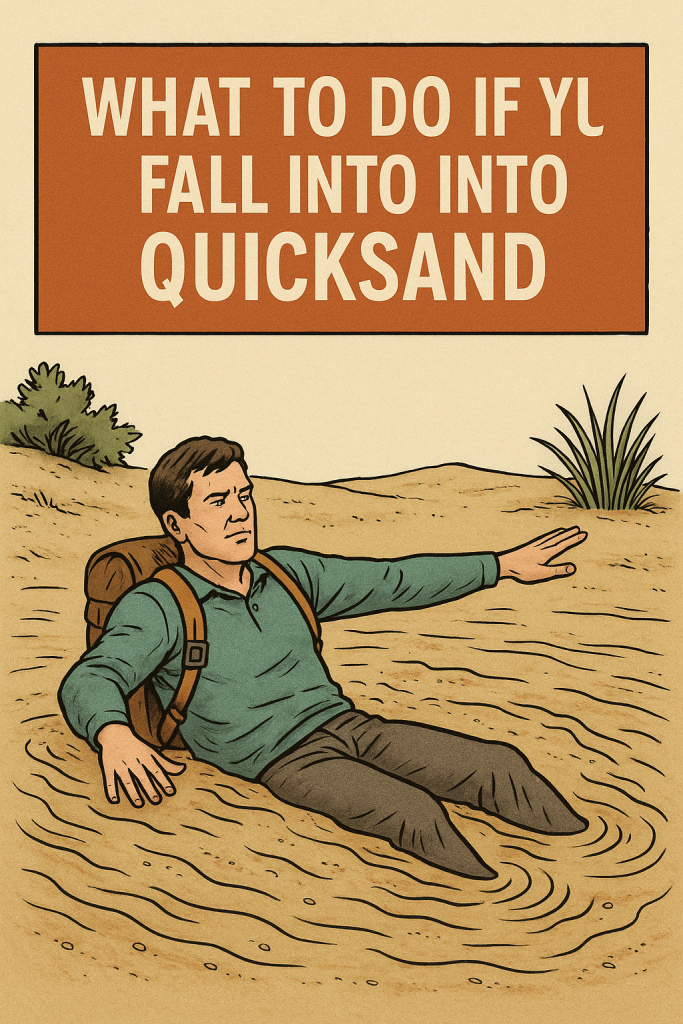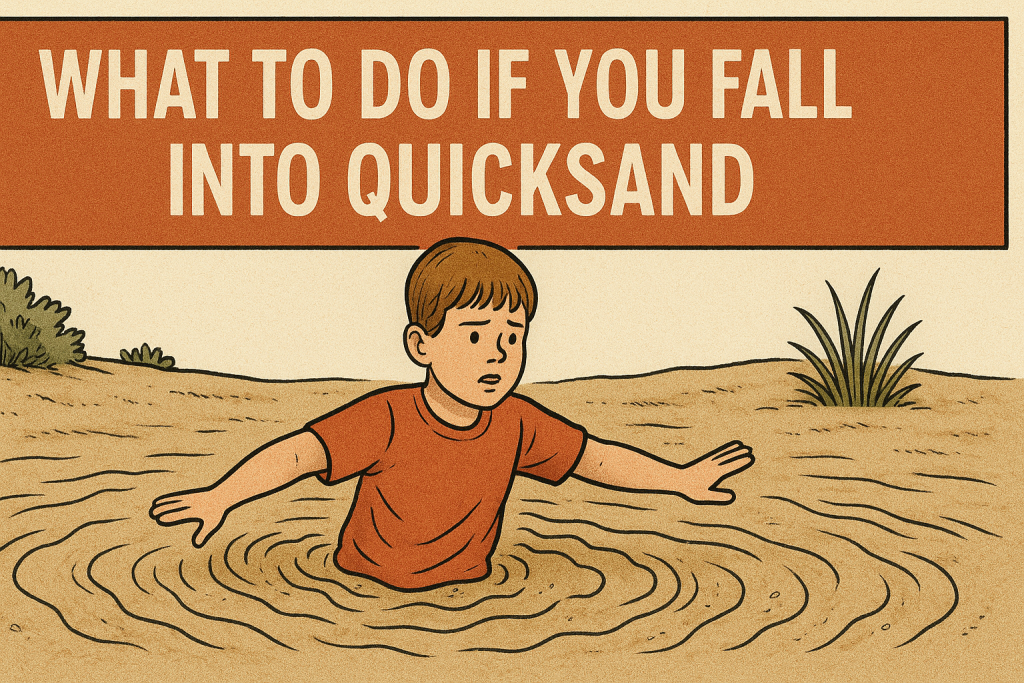⏲️ Estimated reading time: 7 min
🌍 What To Do If You Fall Into Quicksand – A Complete Survival Guide
Quicksand is not the bottomless death trap movies made us believe. By staying calm and using the right techniques, you can escape safely. This complete guide explains what to do, common myths, real-life examples, and prevention tips.
Why Quicksand Is Misunderstood
Quicksand has fascinated and terrified people for centuries. In countless movies, books, and adventure stories, quicksand is shown as a merciless trap that swallows people whole, never to be seen again. Think of classic jungle adventures where heroes and villains alike are dramatically consumed by this strange natural hazard.
But here’s the truth: quicksand is dangerous, but it doesn’t work like Hollywood wants you to believe. It won’t drag you down to the center of the Earth, but it can trap you, exhaust you, and put you in serious danger if you panic.
In this article, we’ll explore what quicksand really is, how it works, survival strategies, myths versus facts, and even some real-world cases of people who escaped.
By the end, you’ll know exactly what to do if you ever find yourself sinking into this mysterious mix of sand and water.
What Exactly Is Quicksand?
Quicksand is not a special type of sand. Instead, it’s a mixture of sand, water, and sometimes clay or silt. When the sand becomes saturated with water, the grains lose their solid structure and act more like a liquid than a solid.
It behaves like a non-Newtonian fluid – meaning its properties change depending on pressure. If you move slowly, it behaves more like water, letting you float. If you move quickly, it stiffens and traps you.
How It Forms
- Saturated ground: Underground water bubbles up and loosens sand.
- Low drainage: Areas where water can’t escape allow sand to remain unstable.
- Tidal shifts: Beaches and coasts often develop quicksand after tides recede.
Common Locations
- Riverbanks
- Marshes and wetlands
- Coastal shorelines
- Floodplains
- Tropical jungles
Quicksand can appear almost anywhere there’s sand and water – it’s not limited to fascinating locations.
The Psychology of Quicksand
The real danger of quicksand isn’t the sand itself – it’s fear and panic.
When people panic, they thrash violently, trying to force their way out. This reaction increases downward pressure, creating a suction effect and making escape harder. Exhaustion sets in quickly, and if you’re in a remote area, fatigue can be fatal.
Understanding that quicksand is survivable is the first step to staying calm.
What NOT To Do When You Fall Into Quicksand
If you suddenly find yourself sinking, your instincts may betray you. Here are the common mistakes that can cost you your life:
- Don’t Panic. Thrashing is your worst enemy.
- Don’t Try to Yank Your Legs Straight Up. This creates vacuum suction.
- Don’t Lean Forward. Your torso can sink deeper, making escape harder.
- Don’t Struggle Rapidly. Fast movements stiffen the sand, locking you in.
- Don’t Ignore Your Surroundings. There may be branches, rocks, or people who can help.

Step-by-Step Survival Guide
1. Stay Calm and Breathe Slowly
The moment you realize you’re in quicksand, pause. Remind yourself: You won’t sink completely. The human body is less dense than quicksand. You can and will float if you control yourself.
2. Spread Out Your Weight
Extend your arms wide to distribute your body’s weight. This prevents further sinking and increases buoyancy.
3. Lean Back Slowly
Recline until you’re almost lying on your back. This turns your body into a floating “raft.” The wider your body surface, the easier it is to stay afloat.
4. Free Your Legs Gradually
Wiggle your legs gently in circular motions. Imagine swimming underwater – the idea is to let water seep around your legs, loosening the grip of the sand.
5. Move Horizontally, Not Vertically
Instead of trying to climb straight up, slide your body horizontally toward firm ground. Small swimming-like motions work best.
6. Use Tools If Available
If you’re carrying a stick, trekking pole, or backpack, use it to distribute weight or as leverage. A floating backpack can act as a buoy.
7. Signal for Help If You’re Not Alone
If you’re with someone, calmly ask them to find a branch or rope. They should never jump in – instead, they must stay on solid ground and pull gently while you move.
Real-Life Examples of Quicksand Survival
- Case 1: Hiker in Utah (2019): A man fell into quicksand in Zion National Park. He remained stuck for 12 hours before rescue. His survival was due to staying calm and conserving energy.
- Case 2: Soldier Training Exercise: Military reports from swamp training describe recruits sinking waist-deep. Those who panicked had to be pulled out, while those who leaned back floated until they could slide free.
- Case 3: Beachgoers in England (2017): Several tourists were trapped in tidal quicksand. Rescuers advised them to lie flat and remain calm until they were safely pulled out.
These cases show that knowledge, patience, and calmness are the keys to survival.
Myths vs. Facts About Quicksand
| Myth | Reality |
|---|---|
| Quicksand swallows people whole. | The human body is too buoyant to sink completely. |
| Quicksand exists only in jungles. | It can occur on beaches, rivers, and even deserts. |
| You can’t escape without help. | With correct technique, self-rescue is possible. |
| Animals and cars can sink entirely. | Large objects may sink deeper, but usually stop halfway. |
Special Situations
If You’re Alone
- Use breathing control.
- Lie back, float, and slide toward safety.
- Conserve energy and move slowly.
If You’re With a Partner
- Partner should never enter the quicksand.
- Use a stick, rope, or clothing as an extension.
- Pull slowly, synchronized with your movements.
Carrying a Backpack
- Unclip it immediately if it drags you down.
- If waterproof, use it as a flotation device.
Preventing Quicksand Accidents
- Research your hiking area. Know if rivers, marshes, or tidal zones are nearby.
- Avoid suspicious wet ground. Especially after heavy rainfall.
- Carry a trekking pole. Test the ground ahead of you.
- Never travel alone in risky zones. Companions can save your life.
- Equip survival gear. Rope, whistle, and waterproof pack can make a difference.

Scientific Perspective – Why You Float
Studies show that quicksand is denser than water, with a density of about 2 g/cm³, compared to the human body’s average of 1 g/cm³. That means you’ll float – just like in the Dead Sea – if you stay calm and spread out.
The problem isn’t sinking, but being trapped and immobilized. Panic creates exhaustion, which can lead to dehydration, hypothermia, or drowning if tides rise.
Final Survival Checklist
- ✅ Stay calm, breathe slow
- ✅ Spread arms wide
- ✅ Recline onto your back
- ✅ Wiggle legs gently to break suction
- ✅ Slide horizontally toward safety
- ✅ Use tools, not brute strength
- ✅ Signal for help calmly
- ✅ Avoid panic and conserve energy
Wrap-Up
Quicksand is far less deadly than movies suggest, but it is still a serious survival hazard. The key to escape is calmness, patience, and technique. Your body is naturally buoyant, and by spreading out your weight, moving slowly, and sliding to safety, you can survive.
The real danger comes from fear, exhaustion, or environmental factors like tides or extreme heat. With the right mindset and preparation, you can transform a terrifying moment into a story of resilience and survival.
🔔 For more tutorials like this, consider subscribing to our blog.
📩 Do you have questions or suggestions? Leave a comment or contact us!
🏷️ Tags: quicksand survival, outdoor safety, natural hazards, hiking dangers, survival skills, escaping quicksand, self rescue, adventure safety, emergency preparedness, outdoor tips
📢 Hashtags: #quicksand, #survivaltips, #outdoorsafety, #hikinglife, #naturehazards, #adventuresafety, #emergencyskills, #outdoorlife, #safetravel, #survivalguide
Only logged-in users can submit reports.
Discover more from HelpZone
Subscribe to get the latest posts sent to your email.


Feeling fully prepared to encounter quicksand outside my New York City apartment.